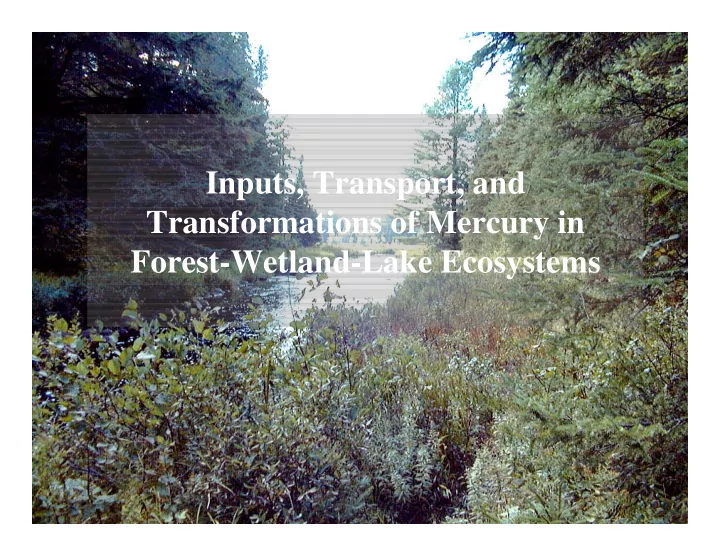

Inputs, Transport, and Transformations of Mercury in Forest-Wetland-Lake Ecosystems
Outline • Background • Mercury in Adirondack Lake/Watersheds • Historical Patterns of Mercury Deposition • Utility Emission Controls • Conclusions
Forms of Mercury Hg 0 Elemental Mercury Gas phase, highly insoluble Not highly toxic High exposure to vapors cause a neurotoxic response, “mad hatter” syndrome Hg 2+ Ionic Mercury Liquid phase, soluble Not highly toxic Damage g.i. tract, kidneys and liver CH Hg + Monomethyl Mercury 3 Biological tissue (muscle) Neurotoxin – most toxic form of mercury
⎛ ⎞ − CH Hg fish ⎜ 3 ⎟ ⎜ ⎟ Bioconcentration Factor (BF) = log − ⎝ ⎠ CH Hg water 3
Mercury in Adirondack Lake/Watersheds
Fish Hg Concentrations Hg Concentrations > 0.5 µg/g > 1.0 µg/g % fish 34 7.3 % lakes 96 65
Sunday Lake Watershed Watershed 1340 ha Upland vegetation second growth forest deciduous – 70% coniferous – 30% Wetlands 20.5% of watershed palustrine forest and shrub conifers, riparian, beaver impoundments Lake Surface area 7.7 ha Mean depth 2.5 m Chemistry pH 5.6 ANC 20 µeq/L DOC 10.3 mg C/L Fish Hg Mean 3+ to 5+ yellow perch 0.88 µg/g
Coniferous Site Deciduous Site Surface water sampling site
30 25 HgT (ng/L) 20 15 10 5 0 10 + (ng/L) 8 6 CH3Hg 4 2 0 18 16 DOC (mg C/L) 14 12 10 8 6 4 2 0 70 SO42- (umol/L) 60 50 40 30 20 10 0 Upland Forest Riparian Wetland Shallow Peat Deep Peat Site
Sunday Lake Inlet
Hg T Flux 20.7 13.2 (ug/m 2 *yr) 10.3 2.1 13.9 5.3 2.4 2.5 1.1 2.0 1.5
MeHg Flux 0.27 (ug/m 2 *yr) 0.31 0.06 0.29 0.13 0.26 0.45 0.36 0.62 0.13 0.14
Historical Patterns of Hg Deposition
Sediment Hg T Fluxes Preindustrial, maximum, and modern Hg T fluxes (µg/m 2 -yr; 1998 values) of the Adirondack study lakes, along with the ratios obtained relative to background values Lake Preindustrial Maximum Maximum Modern Modern Flux Flux (years Flux (year) Flux Ratio Flux (year) Ratio averaged) Big Moose 16.0 90 (1973) 5.7 62 4.0 2.3 13 (1979) 5.8 11 4.7 Little Echo Merriam 6.9 27 (1990) 3.9 22 3.2 10.0 46 (1985) 4.5 39 3.8 West 5.2 36 (1985) 6.9 14 2.6 Bear 8.3 116 (1983) 14.0 33 4.0 Queer Upper 14.0 38 (1980) 2.8 33 2.4 Wallface 8.2 26 (1995) 3.1 26 3.1 Clear Avg = 5.8 Avg = 3.5
Utility Emission Controls Emissions Compliance Policy or Proposal Hg Emissions Comments Trading among Date Plants? 1990 Clean Air Act ~48 T N/A N/A Jeffords Bill S.556 ~ 5T 2007 No 5 ton cap (as amended) 90% reduction Smith Bill S.2815 ~15 T 2018 Yes 26 tons per yr by (Clear Skies) 2010 70% reduction 15 tons per yr by 2018 Clinton Bill S.588 No Control N/A N/A Utility MACT Proposed 15 December 2003 Finalized late 2004 Compliance late 2007
Mercury in Adirondack Wetlands, Lakes, and Terrestrial Systems (MAWLTS) Model CANOPY INTERACTIONS ATMOSPHERIC WETLAND Hg PROCESSES DEPOSITION Volat ilizat ion n D Precipit at ion e m o e i t t h c u y d l Hg (O) a e t R i o Part icle n Capt ure Hg (II) CH3 -Hg Throughfall M e n t h i o y l a t SOIL HYDROLOGIC SOIL CHEMICAL WETLAND WATER PROCESSES PROCESSES QUALITY/HYDROLOGY … … Rain R-SH Hg R-SH Hg ET Organic Complexat ion … … Clay Hg Hg Sorpt ion
Model Hg Forms and Compartments • Hg forms: – Inorganic Hg(II) – Methylmercury – Elemental mercury • Compartments: – Surface Water – Up to 5 sediment layers
Preliminary Calibration: Methyl Hg 1 Simulated Observed 0.8 Methyl Hg (ng/l) 0.6 0.4 0.2 0 Jan/1/00 Mar/1/00 May/1/00 Jul/1/00 Aug/31/00 Oct/31/00 Dec/31/00
Simulated Response of Total Hg: 50% Decrease in Atmospheric Deposition 10 Total Hg Concentration, ng/l Hg Base 8 Hg Reduced Dep 6 4 2 0 Jan/1/06 Jan/1/99 Jan/1/00 Jan/1/01 Jan/1/02 Jan/1/03 Jan/1/04 Jan/1/05 Date
Conclusions • Mercury is a global contaminant. • Mercury emissions largely occur from electric utilities, nonutility boilers and incinerators. • Mercury emitted as Hg0 is globally dispersed. Mercury emitted as Hg (II) is deposited near the source. • Methyl Hg bioconcentrates up the aquatic food chain. • Virtually every state has fish consumption advisories due to elevated Hg.
Conclusions (cont.) • The forest canopy greatly amplifies atmospheric Hg deposition. • Wetlands are a critical controller of water and fish Hg. • Mercury contamination has increased 5 fold over the last 150 years. • Controls on Hg emissions from electric utilities are being proposed.
Summary (n=1469) No. of Surface area (%) (%) Lakes (ha) pH < 5.0 352 24 2,000 8.4 ANC < 0 388 26 2,650 11 µeq/L
900 R = 0.69 DOC P = 0.0008 700 ) DOC (µmol C L -1 500 300 100 0 10 20 30 40 % Wetland Area
Typical Mercury Concentration in Freshwater (ng/L) SITE TOTAL Hg REFERENCE Remote Lakes Wisconsin Fitzgerald & Watras 1989 0.9 – 1.9 Washington (state) 0.2 Bloom 1989 California 0.6 Gill & Bruland 1990 Manitoba 0.2 – 1.1 Bloom & Effler 1990 Montana Watras et al. 1995 0.35 2.8 Sweden Lee & Iverfeldt 1991 1.4 15 Wisconsin 0.28 – 4.9 Watras et al. 1995 - Adirondacks This study 0.8 – 6.1 Urban Lake Washington (state) Bloom & Watras 1989 1.7 Great Lakes Erie 3.9 Gill & Bruland 1990 Ontario 0.9 Gill & Bruland 1990 Mining Contaminated Lakes Gill & Bruland 1990 3.6 – 104 Clear Lake Davis Creek Reservoir Gill & Bruland 1990 5.2 – 6.4 Chlor-Alkali Contaminated Lakes Bloom & Effler 1990 7 – 19 Onondaga Lake Clay Lake (Ontario) 5 – 80 Parks et al. 1989
Recommend
More recommend